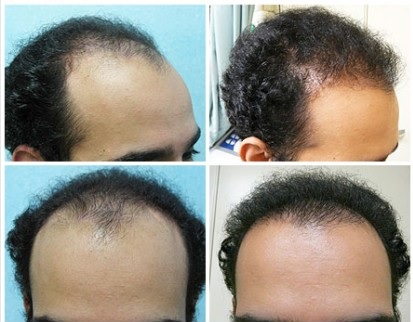The technique and surgeon decide the long-term fate of your restoration, but the trouble is knowing what or who to choose. Advertisements, clinic websites, and consultations may tell you what you want to hear, but hair transplant images provide irrefutable evidence of a technique’s capabilities or a surgeon’s skill.
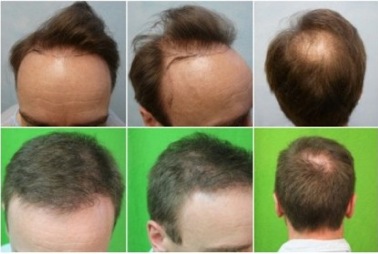
HAIR LOSS
Hair loss plagues millions of people, currently afflicting 21 million American women and 40 million American men. The origins range from pattern baldness—the leading cause—to anemia, hormonal changes, diabetes, traction alopecia, lupus, and many more.
The main cause, also known as androgenic alopecia, comes from a predisposed susceptibility to the ordinary hormone dihydrotestosterone, or DHT. And this predisposition comes from genetically weak androgen receptors inherited through one or both parents’ X chromosomes. It is possible for men and women both to experience androgenic alopecia. In men the typical pattern is hairline recession and thinning at the crown. In women, the typical pattern is an even-spread thinning across the top third of the head.
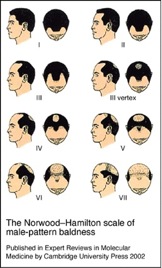
HAIR TRANSPLANT IMAGES AND THEIR INFLUENCE IN YOUR CHOICE OF RESTORATION
There are many means of surgical hair restoration, and studying hair transplant images of their outcomes will clearly show which ones are worthwhile, and which ones will leave you worse off. Different surgery methods include:
- Scalp reduction
- Temporoparietal-occipital flaps
- Punch grafting (obsolete)
- Follicular unit transplant/FUT
- Follicular unit extraction/FUE
- Body hair transplant/BHT
Scalp reduction and flap surgery are rarely used nowadays for hair recovery. Scalp reduction, used for crown loss, excises the bald area of scalp and joins the hair-bearing skin. Flap surgery, used for hairline loss, removes a hair-bearing flap of skin from either side of the head, rotates them, and adjoins them to the hairline. Both are highly invasive and risk permanent nerve damage, among other side effects. Hair transplant repair surgery is frequently used to correct the scarring caused by these procedures, as well as that of punch grafting.
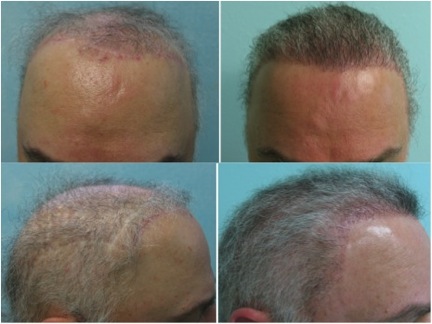
FUT and FUE are the two most popular methods used today. However, a look at FUE and FUT hair transplant images demonstrate an obvious difference in the long-term outcome of each. Both methods implant follicular units (tiny clusters of hair) one at a time into the recipient area, but their excision procedures are vastly different.
FUT, also known as strip surgery, excises a strip of flesh from the back of the patient’s head. This strip is later cut into follicular units. FUE removes each follicular unit individually from the scalp. FUE is a longer, more labor-intensive surgery, but avoids the inevitable linear scaring caused by FUT. It also enables the surgeon to harvest the follicular units from anywhere on the head, such as finer nape grafts, to enhance the aesthetic result. Comparing a FUT hairline with FUE hairline, one will find the latter to appear softer and more natural.
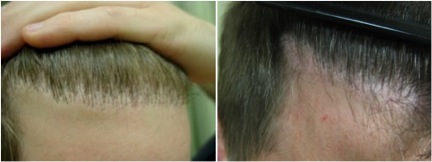
FUE also facilitates body hair transplant—which hair transplant images will show is the only surgery capable of successfully restoring severely bald individuals. BHT uses the individual graft excision method and can harvest hair from the beard, shoulders, chest, stomach, legs, and arms. FUE and BHT are both minimally invasive microsurgeries, thus healing is quick and scarring is typically nominal.
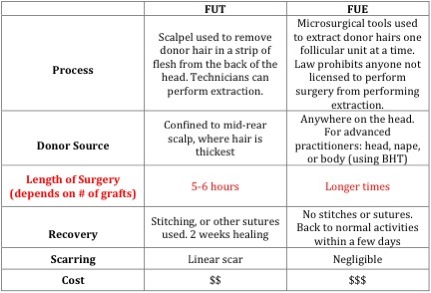
HAIR TRANSPLANT IMAGES: PHOTOS AND VIDEOS
Visual documentation of prior patient outcomes is standard at every clinic. Thus, anywhere you go should be able and willing to show their photos and videos. If a clinic is not forthcoming with these images, or the images appear retouched or edited, go somewhere else. All visual documentation should show prospective patients an honest result, so they know what kind of outcome they can realistically expect. This means images should also be in focus and in good lighting, showing the prior patient from multiple angles.
Good quality hair transplant images should show the crown whorl, hairline design, and global spacing/coverage. This is the best way for a prospective patient to know whether a surgeon’s experience really supports his/her claims of enduring success.
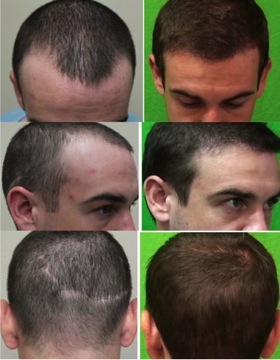
FAQ
Are there any drawbacks to body hair transplant?
The only drawbacks to BHT are the survival rate and the temperament of the follicles. Scalp hair has higher rates of long-term graft survival than body hair. And body hair will continue to act innately, even after transplant. This means chest hair will retain its color, texture, growth rate, and length. A good surgeon will be able to blend body hair extremely well with surrounding head hair, even in light of these drawbacks.
What should I look for in a good surgeon?
A good surgeon will doubtless have the honest hair transplant images to substantiate the value of his/her practice. He/she will also preferably possess a board certification in plastic surgery or dermatology, have years of experience, have a high level of medical skill and artistic vision, use handheld tools, and have a well-trained medical staff.

